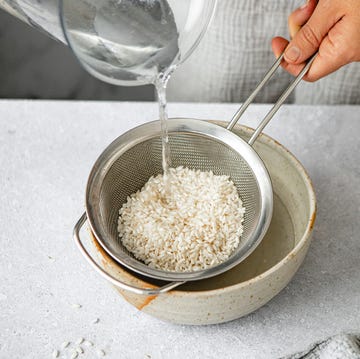There's something about that first snowfall that makes anyone feel like a kid again. Whether you run outside to build a snowman or grab some friends for an epic snowball fight, that fresh and powdery layer of snow on your yard is practically begging for you to play!
It might also seem like the perfect opportunity to try the popular TikTok trend of making ice cream out of snow. You know those frosty treats that have taken the internet by storm? They're basically just scoops of freshly fallen snow with some sweetened condensed milk and vanilla extract added to them. Others have topped them with a drizzle of chocolate sauce or salted caramel.
And while it sure does look like a tasty winter treat and may even be a fun snow day activity for the kids, like many things on TikTok these days, it might have you questioning: Is it safe to eat snow?
Some people argue that snow is exposed to many elements (i.e. deer, rabbits, and even ranch dogs), but others say there's no problem when it comes eating snow. So, to get to the bottom of this snow day debate, here's what the experts have to say.
Is It Safe to Eat Snow?
According to Dr. Mikhail Yakubov of Manhattan Gastroenterology, eating snow is not recommended, especially in areas where it can be exposed to contaminants.
"Snow can contain pollutants from the atmosphere, especially in urban areas," Dr. Yakubov says. Though it may seem like snow goes straight from the clouds to the ground, there's actually much more to it as it falls from the sky. So, here's a little science lesson about how snow is formed: Snow starts out as water vapor high in the clouds and when the temperature gets cold enough, those water vapors freeze and turn into ice crystals, which clump together to form snowflakes. As snowflakes fall, they can pick up air pollutants, dust, or other bacteria. Not to mention, the first snowfall will land on the ground which is susceptible to contamination from dirt, pesticides, or even chemicals used to melt ice on your driveway.
"Snow that sits on the ground can pick up pathogens like bacteria if it's been sitting out for an extensive period of time," Dr. Yakubov says. "I would clearly avoid old snow, but especially avoid any snow that has discoloration, as it may contain additional contaminants."
Though it may sound like no snow is good snow to eat, Dr. Rebekah Diamond, an Assistant Professor of Pediatrics at Columbia University, says to follow your instincts. Eating small amounts of the top layer of snow that are the furthest away from the ground will have the least amount of pollutants. "Like anything, if it's dirty (contaminated by animals, especially) you could get sick," she says.
Dr. Yakubov also confirms that aside from environmental risks, "bacteria from dirt, and animal urine can also pose potential health risk."
That means you should avoid any grey or yellow snow, or any snow that’s a color other than white.
"If traditional symptoms of illness appear: fatigue, lethargy, fevers, chills, rigors, cold sweats, etc., then consider making a doctor's appointment," he warns.
Bottom line: stick to consuming hot chocolate on those chilly snow days.

Kara Zauberman is the Senior Editor of Content Strategy at The Pioneer Woman, covering stories ranging from food, lifestyle, news, and more. When she’s not writing and editing, you can find her seeking out new restaurants or cooking for friends and family.














